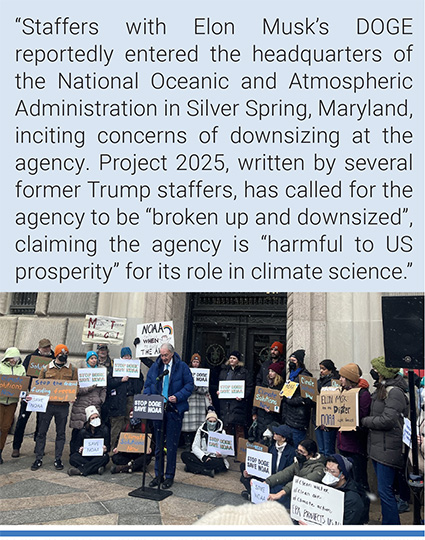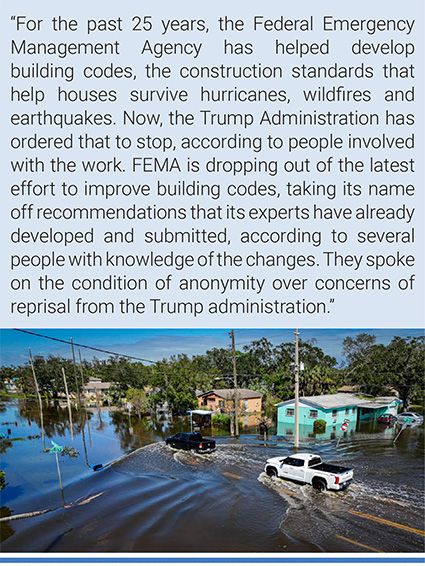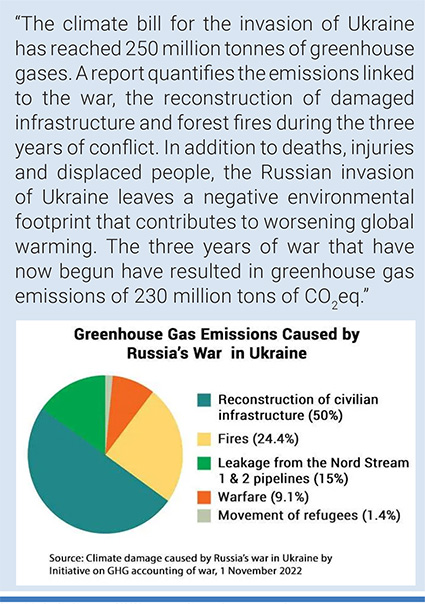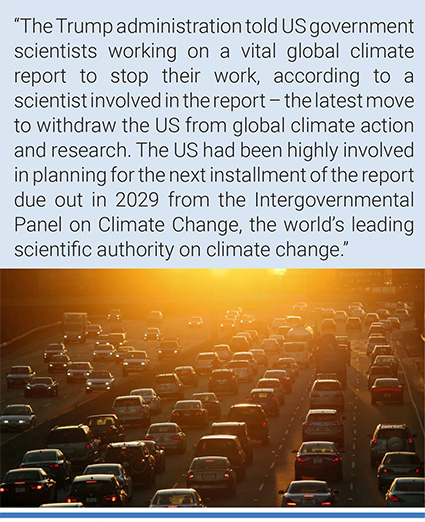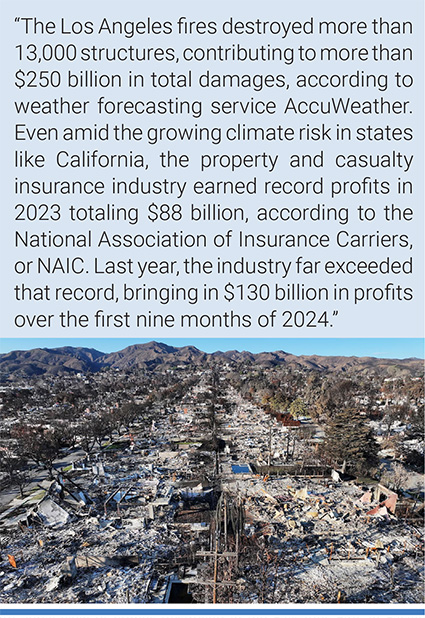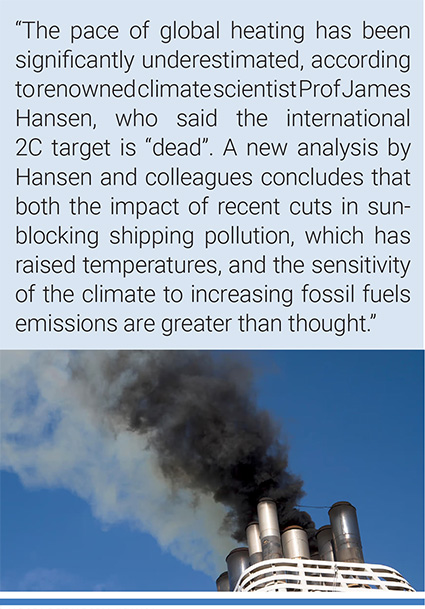Monthly Summaries
Issue 98, February 2025 | "Clunky and sanctimonious in its execution but unimpeachable in its sentiments"
[DOI]

Image captured from Science Moms climate change advertisement. Credit: Science Moms.
February media coverage of climate change or global warming in newspapers around the globe dropped 23% from January 2025. Furthermore, coverage in February 2025 dipped 2% from February 2025. In February, international wire service coverage plunged 36% from the month earlier (January) and 18% from the previous year (February 2025). Figure 1 shows trends in newspaper media coverage at the global scale – organized into seven geographical regions around the world – across 21 years, from February 2004 through February 2025.

Figure 1. Newspaper media coverage of climate change or global warming in print sources in seven different regions around the world, from January 2004 through February 2025.
At the regional level, February 2025 coverage increased in Africa (+10%) compared to the previous month. Meanwhile, coverage went down in Asia (-9%), the European Union (EU) (-21%), Oceania (-30%), Latin America (-33%), North America (-36%) and the Middle East (-37%) (see Figure 2). It appears that climate change news coverage largely took a back seat in February to other issues that were not linked to a heating planet. Meanwhile, Comparing these February 2025 levels of coverage to a year previous (February 2024), numbers were up in Latin America (+7%), the Middle East (+9%), and Asia (+25%). Elsewhere, coverage dropped in Oceania (-4%), North America (-11%), the EU (-16%), and Africa (-26%).

Figure 2. Coverage of climate change or global warming in the Middle East from January 2004 through February 2025: Al Riyadh (Saudi Arabia), Al Sabah (Iraq), Annahar (Lebanon), Daily Star (Lebanon), Gulf Daily News (Bahrain), and Jerusalem Post (Israel).
Among our country-level monitoring, in February US print coverage (see Figure 3) dropped 30% from January 2025 levels of coverage. Coverage in the Wall Street Journal held steady, while coverage dipped 19% at the USA Today, 28% lower in the New York Times, and down 30% at the Washington Post, while going down 44% in the Los Angeles Times.

Figure 3. US newspapers’ – Los Angeles Times, New York Times, USA Today, Wall Street Journal, and Washington Post – coverage of climate change or global warming from January 2000 through February 2025.
A rally against cuts to NOAA in front of the Commerce Department in Washington. Photo: Amelia Davidson/POLITICO's E&E News. |
For what appeared in coverage of climate change or global warming in February 2025, political and economic-themed media stories were dominant among the larger pool of overall accounts. Stories about the consequences from the transition of power in the United States (US) to the Trump administration cycled throughout the month. For an example of one story among many throughout the month, early in February Guardian journalist Michael Sainato wrote about the Department of Government Efficiency (DOGE) efforts to disrupt federal climate science processes. He noted, “Staffers with Elon Musk’s “department of government efficiency” (DOGE) reportedly entered the headquarters of the National Oceanic and Atmospheric Administration (NOAA) in Silver Spring, Maryland, and the Department of Commerce in Washington DC today, inciting concerns of downsizing at the agency. “They apparently just sort of walked past security and said: ‘Get out of my way,’ and they’re looking for access for the IT systems, as they have in other agencies,” said Andrew Rosenberg, a former NOAA official who is now a fellow at the University of New Hampshire. “They will have access to the entire computer system, a lot of which is confidential information.” Project 2025, written by several former Trump staffers, has called for the agency to be “broken up and downsized”, claiming the agency is “harmful to US prosperity” for its role in climate science. Rosenberg noted it had been a longtime goal of corporations that rely on NOAA data to prevent the agency from making the data public, instead of giving it directly to private corporations that create products based on it, such as weather forecasting services. He also argued there was no legal authority to abolish NOAA or reduce its budget, outside of reducing it through Congress. In a second example, New York Times journalist Coral Davenport wrote, “One hundred and sixty-eight employees at the Environmental Protection Agency’s Office of Environmental Justice were placed on administrative leave on Thursday, according to agency officials. The notification of leave, sent via email to employees about 5 p.m., was a major step in President Trump’s widely expected plan to do away with the office. On his first day back in the White House, he signed an executive order to eliminate all government programs on environmental justice, which are aimed at helping poor and minority communities that are face disproportionate amounts of pollution. These communities are often located near industrial areas or other heavily contaminated places. “E.P.A. is working to diligently implement President Trump’s executive orders, including the ‘Ending Radical and Wasteful Government D.E.I. Programs and Preferencing,” said Molly Vaseliou, an E.P.A. spokeswoman, in a statement, referring to a directive to eliminate diversity, equity and inclusion programs. “President Trump was elected with a mandate from the American people to do just this.” Ms. Vaseliou said that the work of the staffers placed on leave “did not relate to the agency’s statutory duties or grant work.” Many of the agency’s additional 100 or so environmental justice employees who work in its regional offices around the country are expected to be the next in line to be placed on administrative leave, said two people familiar with the agency’s plans, who spoke anonymously out of fear of retaliation. By law, no employee can be on administrative leave for more than 10 days in a year. Observers said they interpret the administrative leave notices as a first step toward the eventual shuttering the office”.
FEMA has helped develop building codes for decades, including standards that reduce the risk that houses will flood in storms and hurricanes. Photo: Miguel J. Rodriguez Carrillo/AFP/Getty Images. |
As a third example, US National Public Radio journalist Lauren Sommer shared, “For the past 25 years, the Federal Emergency Management Agency (FEMA) has helped develop building codes, the construction standards that help houses survive hurricanes, wildfires and earthquakes. Now, the Trump Administration has ordered that to stop, according to people involved with the work. NPR has learned that FEMA is dropping out of the latest effort to improve building codes, taking its name off recommendations that its experts have already developed and submitted, according to several people with knowledge of the changes. They spoke on the condition of anonymity over concerns of reprisal from the Trump administration. The recommendations FEMA submitted were filed with the International Code Council (ICC), an independent association that develops building codes used by states and local governments, since the U.S. does not have a national set of codes. The proposals FEMA is retracting its involvement from focus on helping homes survive strong winds, seismic shaking and rising floodwaters. FEMA did not respond to questions about why it made the request and the ICC did not respond to questions about whether they were honoring it. In recent years, Republican leaders have criticized FEMA and building codes, saying the regulations are burdensome. Strengthening building codes has historically been opposed by the homebuilding and construction industries over concerns about the cost. Studies show modern building codes have saved billions of dollars in damage from natural disasters. Disaster experts say it's a concerning move, one not seen under the first Trump Administration…. The ICC convenes experts and stakeholders in the building industry to review and improve building codes every three years and is developing a new set of standards now. After they're approved, many local and state governments across the country adopt the codes, which set the mandatory construction rules in their communities. Since FEMA pays out billions of dollars to help devastated communities rebuild, Congress directed the agency to encourage states to adopt more protective building codes for natural hazards. The damage from flooding alone hits $46 billion per year on average and is only expected to increase as hurricanes and rainstorms get more severe as the climate gets hotter”.
Wes Gillingham of the Northeast Organic Farming Association of New York, one of the plaintiffs. Photo: Bryan Anselm/New York Times. |
Meanwhile as the month unfolded, there were other stories linked to the US Trump Administration’s actions. For example, New York Times journalist Karen Zraick reported, “Organic farmers and environmental groups sued the Agriculture Department on Monday over its scrubbing of references to climate change from its website. The department had ordered staff to take down pages focused on climate change on Jan. 30, according to the suit, which was filed in the United States District Court for the Southern District of New York. Within hours, it said, information started disappearing. That included websites containing data sets, interactive tools and funding information that farmers and researchers relied on for planning and adaptation projects, according to the lawsuit. At the same time, the department also froze funding that had been promised to businesses and nonprofits through conservation and climate programs. The purge then “removed critical information about these programs from the public record, denying farmers access to resources they need to advocate for funds they are owed,” it said. The Agriculture Department referred questions about the lawsuit to the Justice Department, which did not immediately respond to a request for comment. The suit was filed by lawyers from Earthjustice, based in San Francisco, and the Knight First Amendment Institute at Columbia University, on behalf of the Northeast Organic Farming Association of New York, based in Binghamton; the Natural Resources Defense Council, based in New York; and the Environmental Working Group, based in Washington. The latter two groups relied on the department website for their research and advocacy, the lawsuit said. Peter Lehner, a lawyer for Earthjustice, said the pages being purged were crucial for farmers facing risks linked to climate change, including heat waves, droughts, floods, extreme weather and wildfires. The websites had contained information about how to mitigate dangers and adopt new agricultural techniques and strategies. Long-term weather data and trends are valuable in the agriculture industry for planning, research and business strategy”.
Outside of the dominant US political context, there were many other February news stories relating to political and economic issues. For example, in South America Associated Press correspondent Fabiano Maissonnave reported, “Brazil’s government on Tuesday approved joining OPEC+, a group of major oil-exporting nations, signaling the country’s evolution into a major oil state just nine months ahead of hosting the United Nations’ annual climate summit. The National Council for Energy Policy’s approval came in response to an official invitation in 2023. The group includes the 12 members of OPEC, the longstanding group set up to coordinate oil production to stabilize markets, plus 10 more significant oil-producing nations with Russia by far the largest. Though non-OPEC members agree to cooperate with OPEC nations, Brazil won’t have any binding obligation such as production cuts, Mines and Energy Minister Alexandre Silveira said at a news conference. The participation will be limited to the Charter of Cooperation, a permanent forum for OPEC and OPEC+ countries to discuss industry-related issues. The South American country will not participate in decisions… Lula’s pursuit of increased oil production, however, has met criticism as Brazil prepares to host the UN climate summit known as COP30 in November. A central push of the annual climate talks has been to reduce the use of fossil fuels, which when burned releases greenhouse gases that heat the planet”.
|
In Europe, the newspaper El País published an editorial entitled A Less Green Europe about how the European Commission presented a plan to simplify environmental rules with the aim of reducing the regulatory burden on people and businesses. The editors noted, “The core of the reforms is the exemption for small and medium-sized companies from complying with a large part of the new ecological requirements. Among them, the obligation to measure and document the environmental impact of their operations and include it in the information they provide to shareholders and the general public. Large firms must comply with this obligation, but they are given an extension to do so. The need to develop specific plans in this regard in particularly polluting sectors is also eliminated. The same happens with the mechanism for offsetting carbon dioxide emissions for imports, which requires certifying the payment of fees for the purchase from third countries of products such as cement, iron, steel, aluminum and fertilizers. Its objective was to compensate for less stringent emissions control and reduce environmental dumping.”
Moreover, much attention was being paid to Russia’s ongoing invasion of Ukraine, with some stories discussing emissions associated with this conflict. For example, El País journalist Manuel Planelles wrote, “The climate bill for the invasion of Ukraine has reached 250 million tonnes of greenhouse gases. A report quantifies the emissions linked to the war, the reconstruction of damaged infrastructure and forest fires during the three years of conflict. In addition to deaths, injuries and displaced people, the Russian invasion of Ukraine leaves a negative environmental footprint that contributes to worsening global warming. The three years of war that have now begun have resulted in greenhouse gas emissions of 230 million tons of CO₂eq (carbon dioxide equivalent, the unit used to measure these gases). This is an enormous amount, similar to what 120 million combustion cars would emit on average in an entire year. The calculation of the climate footprint of war has been prepared by several experts grouped together in the so-called Initiative on GHG Accounting of War.”
In other European news addressing politics and the economy, there were several stories about Artificial Intelligence and increased electricity demand from fossil fuel sources (thereby contributing more to climate change) in the coming years. For instance, La Vanguardia Piergiorgio M. Sandri noted, “In the midst of a technological race, Europe has this week formalized its commitment to artificial intelligence with an ambitious investment plan. The European data center market, valued at 42.98 billion dollars in 2023, is expected to reach 64.5 billion in 2029, according to a study by the consultancy firm Aritzon. The problem is that these facilities are thirsty not only for water (which they also need), but for electricity. For example, a query on ChatGPT consumes ten times more than one on Google. A recent report by the organization Beyond Fossils Fuels has calculated that electricity demand will soar in Europe by 160% over the course of this decade to serve these infrastructures. By 2030, some 287 Twh will need to be added to the grid per year, the equivalent of Spain's electricity consumption in 2022. It is as if a new member country were joining the European grid”.
Eastbound 101 freeway traffic on a record-hot day in Los Angeles. The Trump administration is blocking federal scientists from working on the IPCC report due out in 2029. Those same scientists have warned global temperatures are rising precipitously. Photo: Al Seib/Los Angeles Times/Getty Images. |
Meanwhile in Asia, there were stories about how various countries – China in particular – are missing emissions reductions targets. Across the world, over 90% of member nation countries missed the February United Nations deadline to submit their 2035 climate pledges. For example, Straits Times reporters discussed how “China missed a key climate target in 2024 and emissions in the world’s second-largest economy rose slightly as coal remained dominant despite record renewable additions, official data showed on Feb 28. The figures mean the world’s biggest emitter is off-track on a key commitment under the Paris climate agreement, analysts said. Beijing’s National Bureau of Statistics (NBS) said carbon intensity, which measures emissions of planet-warming carbon dioxide per unit of gross domestic product, fell 3.4 per cent in 2024 – short of an official goal of 3.9. That also put the country well behind on its goal for an 18 per cent reduction from 2020 to 2025. The data showed carbon emissions rose slightly from 2024, though far short of previous jumps, as experts speculate about whether China may have reached peak emissions ahead of a 2030 target. Still, the data showed it will be “extremely hard” for China to meet a pledge to reduce carbon intensity by 65 per cent of 2005 levels by 2030, said Mr Lauri Myllyvirta, lead analyst at the Centre for Research on Energy and Clean Air”.
Meanwhile, back in North America CNN reporters Ella Nilsen and Laura Paddison noted, “The Trump administration told US government scientists working on a vital global climate report to stop their work, according to a scientist involved in the report – the latest move to withdraw the US from global climate action and research. The US had been highly involved in planning for the next installment of the report due out in 2029 from the Intergovernmental Panel on Climate Change, the world’s leading scientific authority on climate change. The IPCC assesses how the climate crisis is affecting the planet according to the latest science. Its reports take thousands of scientists many years to produce and are used to inform policymakers across the world of the risks posed by global warming. In a sense, all of the world’s current, accepted knowledge about climate change stems from the IPCC and its reports, the first of which was published in 1990. An international meeting of IPCC authors that was scheduled to take place in China next week is now in limbo. Kate Calvin, NASA’s chief scientist and senior climate advisor, was supposed to co-chair the discussion but was impacted by the stop-work order, according to the scientist involved in the report. The meeting was planned to talk about next steps in the development of the report”.
An aerial view of homes destroyed in the Palisades Fire, in Pacific Palisades, California. Photo: Mario Tama/Getty Images. |
Next, cultural-themed stories relating to climate change or global warming filled in February in our lives. To illustrate, ongoing discussions regarding how climate change fueled wildfires across Los Angeles California in the US were pressing on the logics of insurance in many areas. For example, ABC News reporters Matt Gutman, Cho Park, Megan Christie, Kate Holland, Evan Simon, Tomas Navia, and Max Zahn noted, “Soon after wildfires broke out in Los Angeles, California, earlier this month, Jewlz Fahn received a panicked call from her husband, Terry, telling her they needed to evacuate their home in the Pacific Palisades. "For some reason, I wasn't thinking clearly. I grabbed a pair of shorts because I was like, well, it might be hot later today," Terry Fahn said. "I was thinking about packing more. But I was like, 'We'll be back.' And that was a mistake." The couple lost their home in the fire and nearly all of their possessions. While they wait for a rental property to become available, Jewlz and Terry are now living in a hotel room with their dog Coda. Jewlz and Terry Fahn make up one of thousands of Los Angeles households seeking to recover their losses after the devastation. The fires destroyed more than 13,000 structures, contributing to more than $250 billion in total damages, according to weather forecasting service AccuWeather. Insurance companies typically fill the gap, helping homeowners overcome their losses and rebuild their homes. After a natural disaster of this scale, however, questions abound over whether residents will be able to access the funds they need. It’s a nationwide trend amid increasingly frequent climate disasters that some experts say could lead to an "uninsurable future."… Even amid the growing climate risk in states like California, the property and casualty insurance industry earned record profits in 2023 totaling $88 billion, according to the National Association of Insurance Carriers, or NAIC. Last year, the industry far exceeded that record, bringing in $130 billion in profits over the first nine months of 2024, credit rating agency AM Best found. "They're supposed to be a risk-bearing industry, but now, even the slightest hint of what might be a new risk and they're walking away," Douglas Heller, director of insurance at the Consumer Federation of America, told ABC News. "The insurance companies have bulked up their profits even as they were walking away from our state and our communities." Kevelighan disputed such criticism, saying focus on the overall strength of the property insurance industry risks overlooking the business impact of high costs tied to climate events like the California wildfires. "So taking aggregate figures from an industry that represents a large amount of our economy and employs over 3 million people in this country, I think we want to also put it into perspective … these large numbers that we're talking about here," Kevelighan said. Criticism from consumer advocates not only targets the profits earned by insurance companies but also the investments made by the firms. The nation’s insurers hold more than $500 billion in fossil fuel-related assets, according to a study published last year by climate advocacy groups Ceres and Environmental Resources Management, as well as risk-assessment firm Persefoni. Insurers’ holdings in fossil fuel-related assets help perpetuate the climate risk the companies cite for their choice to pause or withhold coverage for some customers, Dave Jones, who served as the California insurance commissioner from 2011 to 2018, told ABC News”.
Also, a climate-related Superbowl advertisement generated news attention in February. For example, New York Times journalist Mike Hale described an advertisement put out by ‘Climate Moms’. He wrote, “the likely progress of climate change is charted along the timeline of a newborn girl’s life. A little clunky and sanctimonious in its execution but unimpeachable in its sentiments”.
Photo: scphoto/Alamy. |
Next, there were February 2025 stories that drew on primarily scientific themes when reporting on climate change or global warming. For instance, new research in the journal Environment: Science and Policy for Sustainable Development current climate models underestimate the rate of actual temperature rise, and this generated considerable news attention. For example, Guardian correspondent Damien Carrington wrote, “The pace of global heating has been significantly underestimated, according to renowned climate scientist Prof James Hansen, who said the international 2C target is “dead”. A new analysis by Hansen and colleagues concludes that both the impact of recent cuts in sun-blocking shipping pollution, which has raised temperatures, and the sensitivity of the climate to increasing fossil fuels emissions are greater than thought. The group’s results are at the high end of estimates from mainstream climate science but cannot be ruled out, independent experts said. If correct, they mean even worse extreme weather will come sooner and there is a greater risk of passing global tipping points, such as the collapse of the critical Atlantic ocean currents”.
As a second illustration of new coverage of climate research in February involved new research in the journal Nature found weakening of the Atlantic Meridional Overturning Circulation due to global warming. For example, staff at The Jerusalem Post wrote, “while the Atlantic Meridional Overturning Circulation (AMOC) is expected to weaken this century due to climate change, a full collapse is unlikely. The study, led by Dr. Jonathan Baker of the Met Office, simulated the development of the AMOC under extreme conditions, including a quadrupling of atmospheric CO₂ levels and a massive influx of meltwater. The researchers used 34 climate simulation models to calculate interactions between the atmosphere, cryosphere, and oceans, considering the Southern and Indian Oceans. "Our modelling study suggests that the AMOC will resist pressures from rising global temperatures and inputs of freshwater into the North Atlantic, with the weakened system being largely driven by winds over the Southern Ocean," said Baker. The main reason for the AMOC's resilience is persistent upwelling in the Southern Ocean, driven by strong westerly winds, which compensates for AMOC weakening. The mechanism prevents a total collapse of the AMOC this century, even under the most extreme climate scenarios, the study found. However, scientists warn that even without a complete collapse, a weaker AMOC could have impacts on the global climate, including disruption to weather patterns, rising sea levels on North Atlantic coastlines, and effects on ocean ecosystems. According to New Scientist, weakening of the AMOC would change global rainfall patterns, impacting crop yields around the world, and in regions like the Mediterranean, there could be alterations in rainfall regimes, leading to more arid conditions and increased droughts”.
Last, media portrayals in February that focused on ecological and meteorological themes in various stories were much less abundant than in January. Yet to start the month, news that January was the warmest year on record generated news attention. For example, New York Times journalist Raymond Zhong wrote, “Even as much of the United States shivered under frigid conditions last month, the planet as a whole had its warmest January on record, scientists said on Thursday. The warmth came as something of a surprise to climate researchers. It occurred during La Niña conditions in the Pacific Ocean, which tend to lower the globe’s average temperature, at least temporarily. Earth’s surface has now been so warm for so much of the past two years that scientists are examining whether something else in the planet’s chemistry might have changed, something that is boosting temperatures beyond what carbon emissions alone can explain. Those emissions, the byproduct of burning coal, gas and oil, remain the main driver of global warming, which reached record levels in both 2023 and 2024. It’s because of La Niña that scientists expected this year to be slightly cooler than the past two years, both of which experienced the opposite pattern, El Niño. The waters of the eastern tropical Pacific oscillate between El Niño and La Niña conditions, influencing weather worldwide by changing the balance between heat in the ocean and heat in the air”.

Figure 4. Examples of newspaper front pages with climate change stories in February 2025.
- report prepared by Max Boykoff, Rogelio Fernández-Reyes, Ami Nacu-Schmidt, Jeremiah Osborne-Gowey and Olivia Pearman

